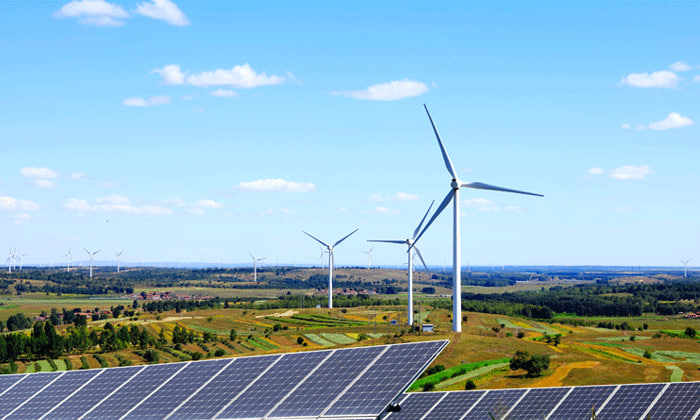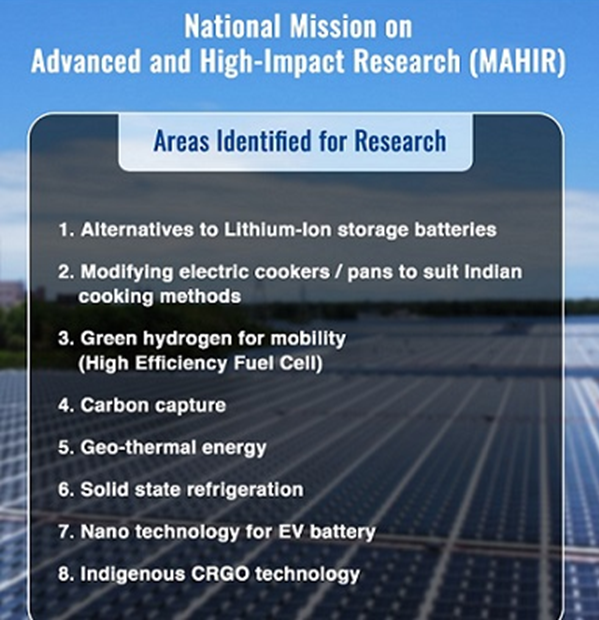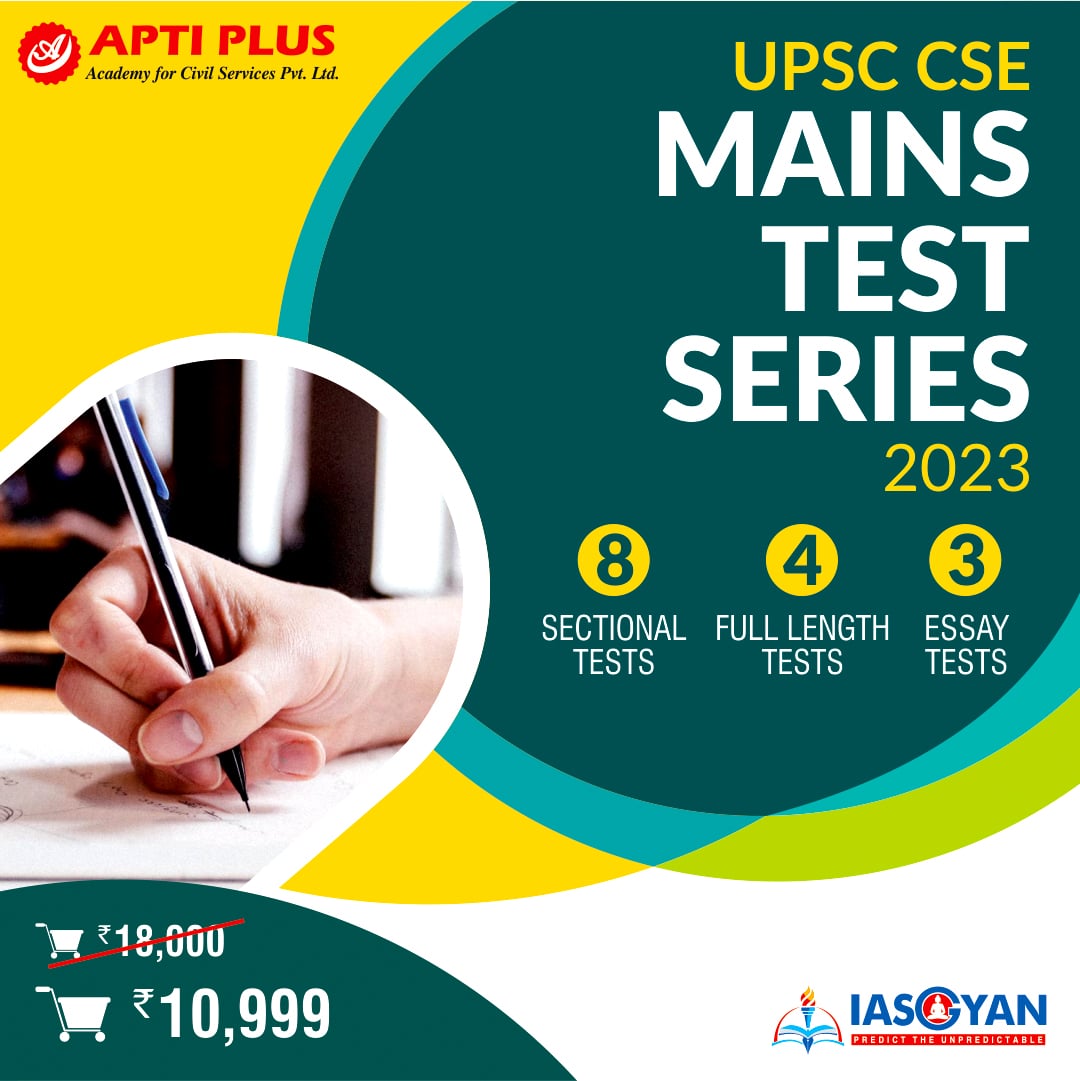
Copyright infringement not intended
Context: The Government of India has initiated a National Mission to support and promote cutting-edge and impactful research in various fields. The mission is named “Mission on Advanced and High-Impact Research (MAHIR)”. It aims to foster a culture of excellence and innovation among Indian researchers and institutions.
Mission on Advanced and High-Impact Research (MAHIR)
About
- It is a national initiative launched by the Ministry of Power and the Ministry of New and Renewable Energy in June 2023.
- The mission aims to leverage emerging technologies in the power sector through indigenous development and collaboration.
Background
- India is one of the fastest-growing economies in the world, with a projected annual growth rate of more than 7% in the coming years. This implies a high electricity demand, which is expected to increase by close to 10%.
- India is committed to achieving net zero emissions by 2070, as well as promoting initiatives like Make in India and Start-up India. These national priorities require a transformational approach driven by research and innovation in the power sector.
.jpeg)
However, India faces several challenges in developing and deploying advanced and high-impact technologies in the power sector. Some of these challenges are:
- Lack of adequate funding and infrastructure for research and development.
- Lack of coordination and collaboration among various stakeholders such as academia, industry and government.
- Lack of awareness and adoption of emerging technologies by end-users and consumers.
- Lack of indigenous capabilities and dependence on foreign technologies.
- Lack of standardization and regulation for new technologies.
To address these challenges and harness the potential of emerging technologies in the power sector, the Ministry of Power and the Ministry of New and Renewable Energy have jointly launched the Mission on Advanced and High-Impact Research (MAHIR).
The Mission on Advanced and High-Impact Research (MAHIR) has the following features:
- It is a national mission that will span an initial period of five years from 2023-24 to 2027-28.
- It will follow the technology life cycle approach from idea to product.
- It will be funded by pooling financial resources of the Ministry of Power, the Ministry of New and Renewable Energy and the Central Public Sector Enterprises under the two Ministries.
- It will establish a two-tier structure comprising a Technical Scoping Committee (TSC) and an Apex Committee.
- The TSC, led by the Chairperson of the Central Electricity Authority, will identify emerging research areas globally, recommend potential technologies, and monitor approved research projects.
- The Apex Committee, chaired by the Union Minister for Power & New and Renewable Energy, will deliberate on technology and product development, approve research proposals, and explore international collaborations.
- The Mission has initially identified eight areas for research, including alternatives to Lithium-Ion storage batteries, modifying electric cookers for Indian cooking methods, green hydrogen for mobility, carbon capture, geothermal energy, solid-state refrigeration, nano-technology for EV batteries, and indigenous CRGO technology.
- Once research areas are approved by the Apex Committee, funding proposals will be invited globally, and selections will be made based on quality cum cost-based selection.
- Pilot projects by Indian start-ups will also be funded, and commercialization will be facilitated through Central Public Sector Enterprises.
- The Mission will actively seek international collaborations for knowledge exchange and technology transfer.
The following eight areas are identified for research:
Alternatives to Lithium-Ion storage batteries
- Lithium-ion batteries are widely used to power various devices, but they have environmental and safety drawbacks. Some of the promising alternatives to lithium-ion batteries include hydrogen fuel cells, redox flow batteries, glass batteries, and magnesium and silicon batteries. These alternatives have advantages such as higher energy density, longer lifespan, lower cost, and lower flammability.
Modifying electric cookers/pans to suit Indian cooking methods
- Electric cookers and pans are convenient and energy-efficient appliances, but they may not be suitable for some of the traditional Indian cooking methods, such as frying, roasting, or baking. Some of the possible modifications to electric cookers/pans to suit Indian cooking methods include adding temperature sensors and timers, using non-stick or ceramic coatings, designing detachable or foldable handles, and incorporating steam vents or pressure regulators.
Green hydrogen for mobility (High-Efficiency Fuel Cell)
- Green hydrogen is hydrogen produced from renewable energy sources, such as solar or wind power. It can be used as a clean and sustainable fuel for mobility applications, such as cars, buses, trucks, or trains. To use green hydrogen for mobility, a high-efficiency fuel cell is needed to convert the hydrogen into electricity.
- Some of the challenges and opportunities for developing a high-efficiency fuel cell include improving the catalysts and membranes, reducing the cost and weight, enhancing the durability and reliability, and integrating with other systems.
Carbon capture
- Carbon capture is the process of capturing carbon dioxide (CO2) from industrial or power generation sources and storing it underground or using it for other purposes. Carbon capture can help reduce greenhouse gas emissions and mitigate climate change. Some of the current and emerging technologies for carbon capture include absorption, adsorption, membrane separation, cryogenic distillation, and chemical looping.
Geothermal energy
- Geothermal energy is the heat stored in the Earth's crust, which can be used to generate electricity or provide heating and cooling. Geothermal energy is a renewable and reliable source of energy that has a low environmental impact.
- Some of the factors that affect the feasibility and performance of geothermal energy systems include the temperature and depth of the geothermal resource, the availability and quality of water, the geological and hydrological conditions, and the social and economic aspects.
Solid-state refrigeration
- Solid-state refrigeration is a type of cooling technology that does not use any refrigerant gas or liquid but relies on the thermoelectric or electrocaloric effect of certain materials. Solid-state refrigeration has advantages such as higher efficiency, lower noise, smaller size, and lower maintenance.
- Some of the challenges and opportunities for developing solid-state refrigeration include finding suitable materials with high thermoelectric or electrocaloric coefficients, optimizing the design and fabrication of the devices, enhancing the heat transfer and dissipation mechanisms, and scaling up for commercial applications.
Nanotechnology for EV battery
- Nanotechnology is the manipulation of matter at the nanoscale (1-100 nanometers), which can result in novel properties and functions. Nanotechnology can be applied to enhance the performance and safety of electric vehicle (EV) batteries, such as lithium-ion batteries.
- Some of the benefits of nanotechnology for EV batteries include increasing energy density and power density, extending the cycle life and shelf life, reducing the charging time and self-discharge rate, and preventing thermal runaway and fire hazards.
Indigenous CRGO technology
- CRGO stands for cold-rolled grain-oriented steel, which is a type of electrical steel with high magnetic permeability and low core loss. CRGO is used to make transformers, motors, generators, and other electrical devices. Indigenous CRGO technology refers to developing and producing CRGO steel domestically, rather than importing it from other countries.
- Indigenous CRGO technology can help reduce the dependence on foreign suppliers, lower the cost of electrical devices, improve the quality and efficiency of power transmission and distribution, and support the growth of domestic industries.

Working Structure
- MAHIR will operate through a two-tier structure comprising a Technical Scoping Committee and an Apex Committee. The Technical Scoping Committee, led by the Chairperson of the Central Electricity Authority, will:
- Identify existing and emerging research domains on a global scale.
- Recommend potential technologies for development, outline research plans, and monitor approved projects.
- The Apex Committee, chaired by the Union Minister for Power & New and Renewable Energy, will:
- Deliberate on the technologies and products to be developed.
- Approve research proposals and consider international collaborations.
- The mission will invite proposals from companies and organizations worldwide for funding based on quality cum cost-based selection. It will also support pilot projects by Indian start-ups and facilitate their commercialization through Central Public Sector Enterprises. The mission will actively seek international collaborations for knowledge exchange and technology transfer
MAHIR has several significances for India's power sector. Some of these are:
- It will facilitate indigenous research, development and demonstration of the latest and emerging technologies in the power sector.
- It will leverage emerging technologies as the main fuel for future economic growth and thus make India a manufacturing hub of the world.
- It will catalyze national priorities such as achieving Net Zero emissions and promoting initiatives like Make in India and Start-up India.
- It will contribute towards achieving the United Nation’s Sustainable Development Goals (SDGs).
- It will create an ecosystem for innovation and translation of research in the power sector through industry-academia-government collaboration.
- It will develop India's capabilities and make significant contributions to the global power sector.
MAHIR also faces some challenges in its implementation and execution. Some of these are:
- Ensuring adequate and timely funding for research projects.
- Ensuring effective coordination and communication among various stakeholders.
- Ensuring quality and relevance of research outputs and outcomes.
- Ensuring the adoption and diffusion of new technologies by end-users and consumers.
- Ensuring compliance and compatibility of new technologies with existing systems and standards.
- Ensuring protection and promotion of intellectual property rights.
- Ensuring ethical and social implications of new technologies.
MAHIR is a visionary and ambitious initiative that can transform India's power sector and position it as a global leader in emerging technologies. However, to realize its full potential, the Mission requires the following:
- A clear vision and strategy for identifying, developing and deploying advanced and high-impact technologies in the power sector.
- A strong commitment and support from the government, industry and academia for funding, facilitating and fostering research and innovation in the power sector.
- A robust mechanism for monitoring, evaluation and feedback for ensuring the quality, relevance and impact of research projects.
- A proactive approach for engaging with international partners for knowledge exchange and technology transfer.
- A holistic approach for addressing the technical, economic, social and environmental aspects of new technologies in the power sector

Conclusion
- The Mission on Advanced and High-Impact Research (MAHIR) is a timely and relevant initiative that can enable India to achieve its national goals and global aspirations in the power sector. It is hoped that the Mission will succeed in creating a culture of innovation and excellence in the power sector and make India a hub of advanced and high-impact technologies in the world.
|
PRACTICE QUESTION
Q. The term “MAHIR” is frequently seen in the news. It is related with;
A) Skill Development Mission
B) Higher Education Mission
C) Research Mission
D) Malware
Answer: C
|
https://pib.gov.in/PressReleaseIframePage.aspx?PRID=1930368





